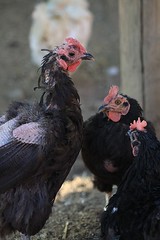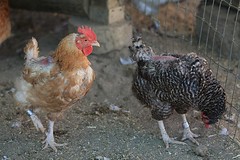Ten of the hens were in pretty bad shape with significant feather loss. The location of the feather loss indicates that the farm has too many roosters for their hen population. The hens are a variety of different breeds and have been moved into a special-needs enclosure until they are healthy enough to be with the rest of the birds, including our resident roosters. We maintain a healthy rooster:hen ratio which helps avoid fighting amongst roosters and overmounting.
In addition to taking in the ten hens, we agreed to take in one adorable polish crested hen with a split beak. We hope when she is released into the main group, she will fall totally in love with Diablo. I have named her Anastasia which may or may not be approved by the rest of the staff.
Some more photos:











2 comments:
I have questions! :-)
What causes a split beak?
And what is your healthy hen:rooster ratio?
We might be moving soon, and if we do, I'd like to get a slightly larger chicken house at the new place and possibly adopt a few more from you guys. Fingers crossed...
It could be a nutritional defect or genetic. Some split beaks actually grow out, most don't.
A nice rooster:hen ratio is 1 rooster for every 4-8 hens. Right now, we have about seven hens for every rooster.
Our fingers are crossed for you!!
Post a Comment